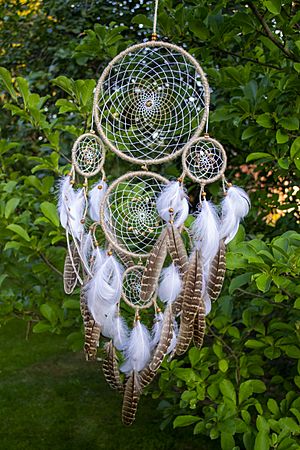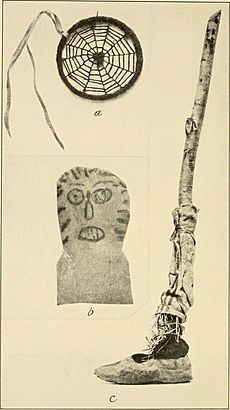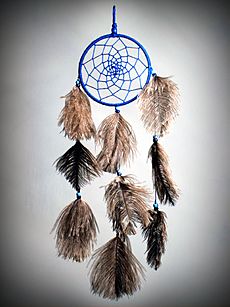Dreamcatcher facts for kids
A dreamcatcher is a special handmade object from some Native American and First Nations cultures. It is usually a willow hoop with a net or web woven inside. People often decorate it with feathers or beads.
Traditionally, dreamcatchers are hung above a baby's cradle or bed. They are meant to offer protection. The idea comes from the Anishinaabe people. They called it "the spider web charm" or "dream snare." It was a hoop with woven string, like a spider's web, to protect babies.
Dreamcatchers became more widely known in the 1960s and 1970s. This was during a time when many Native American groups wanted to show their shared culture. By the 1980s, they became popular "Native crafts items."
Where Dreamcatchers Come From
The Ojibwe people have a legend about where these protective charms came from. It tells of Spider Woman, named Asibikaashi. She was said to care for all the children and people on the land.
As the Ojibwe Nation grew and spread out, it became hard for Asibikaashi to reach every child. So, mothers and grandmothers began to weave webs for their children. They used willow hoops and strong plant fibers.
These charms were meant to catch any harm that might be in the air. Just like a spider's web catches and holds whatever touches it. This story shows that dreamcatchers were first used for protection, not just for dreams.
Basil Johnston, an elder from the Neyaashiinigmiing community, also shared a story. In his book Ojibway Heritage (1976), he talks about Spider (asabikeshiinh). Spider is a clever character who catches a Snake in his web.
Dreamcatchers Today
Dreamcatchers are still used in traditional ways by their original communities. But they also became a symbol for the wider Pan-Indian movement. This movement aimed to unite different Native American cultures. It became a way to show pride in Native American or First Nations heritage.
The name "dream catcher" became well-known to everyone in the 1970s. By the 1980s, it was a very popular craft item. In the early 1990s, it was one of the most sold Native crafts.
As dreamcatchers became popular outside Native communities, many new kinds appeared. Some of these look very different from traditional ones. They might use materials that were not used originally. Some people see this as harmless. However, many Native Americans feel that these imitation dreamcatchers are too commercial. They believe they are used wrongly by people who are not Native. This is called cultural appropriation.
A special dreamcatcher is used by the Little Thunderbirds Drum and Dance Troupe. They are from the Red Lake Indian Reservation in Minnesota. This dreamcatcher is a symbol of hope and healing. The troupe shares it with students at other schools who have experienced difficult events. They travel to meet students, share songs and stories, and give them the dreamcatcher. This dreamcatcher has been passed from Red Lake to schools like Columbine, Colorado, Sandy Hook, Connecticut, and Parkland, Florida.
See also
- God's eye
- Indian Arts and Crafts Act of 1990
- In Spanish: Atrapasueños para niños




